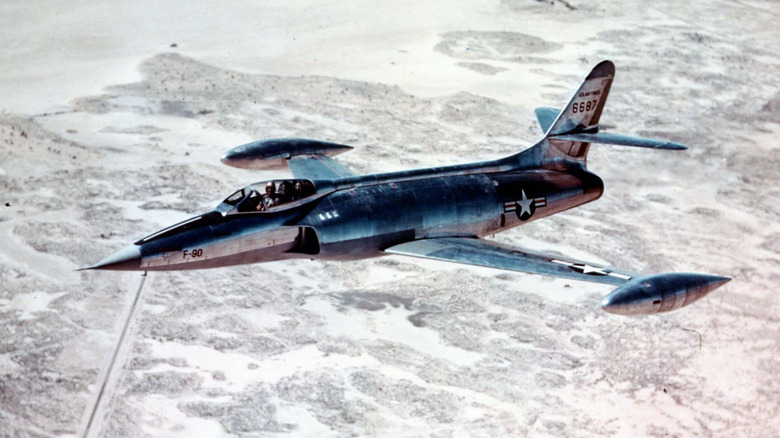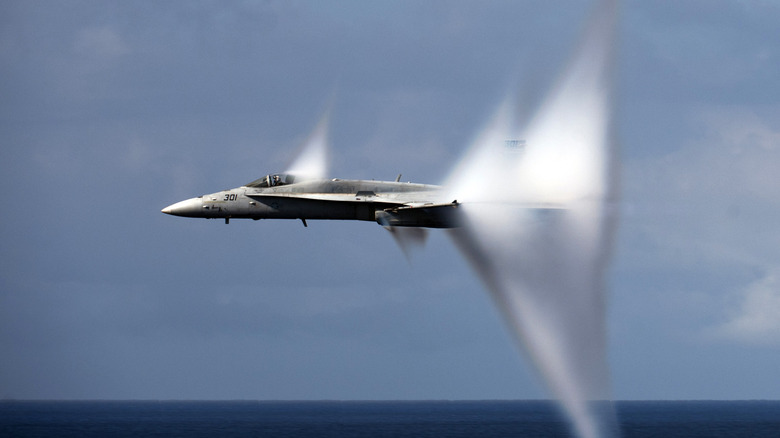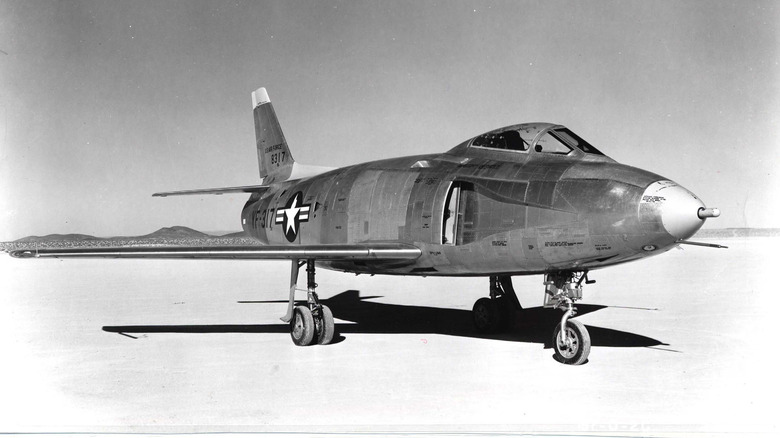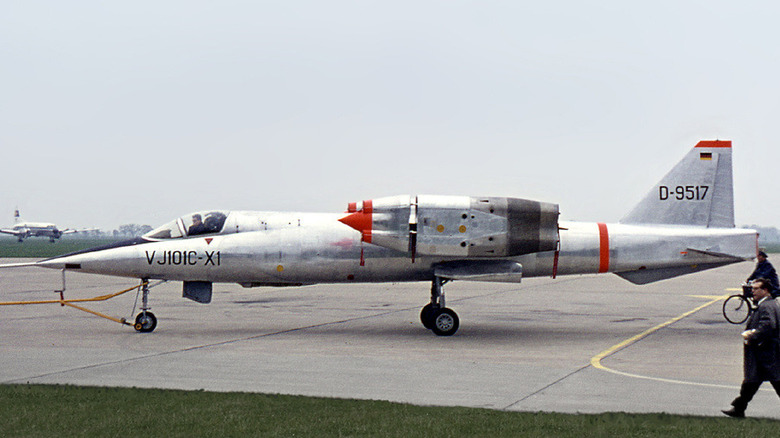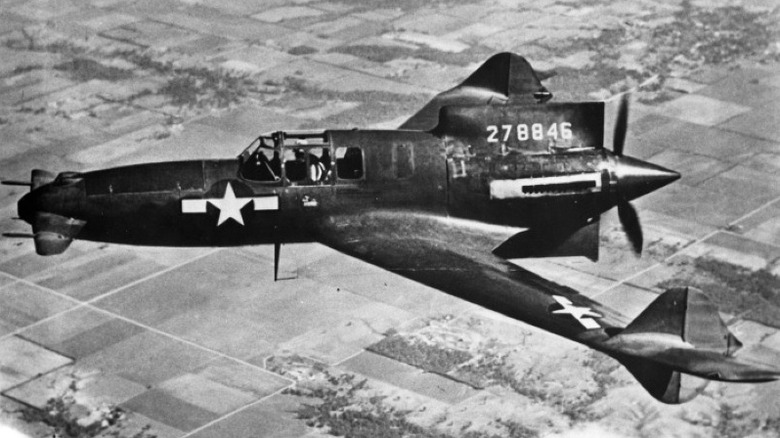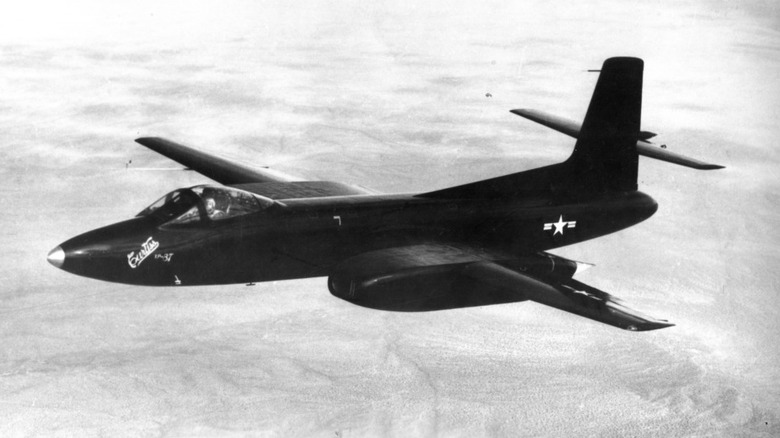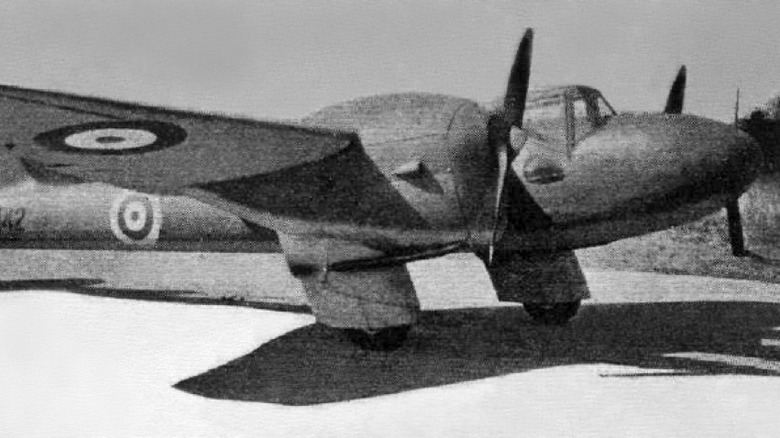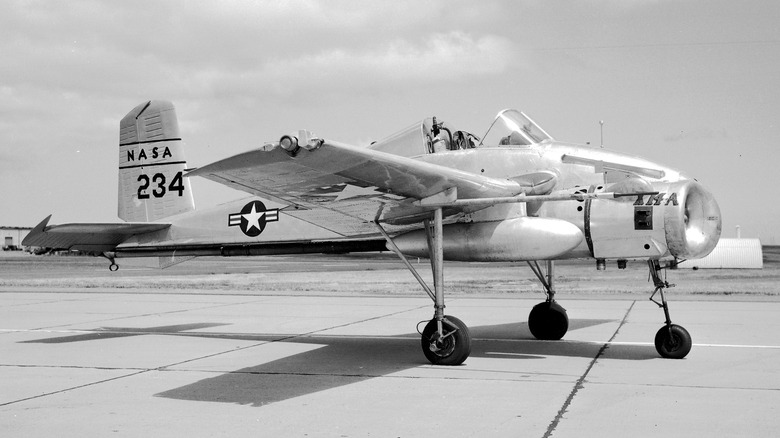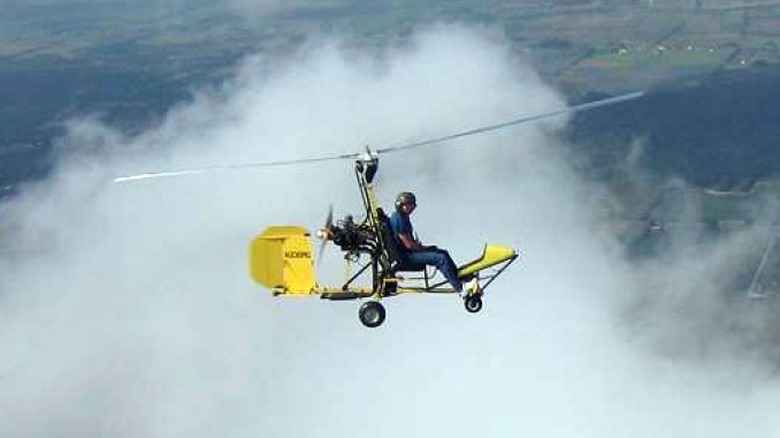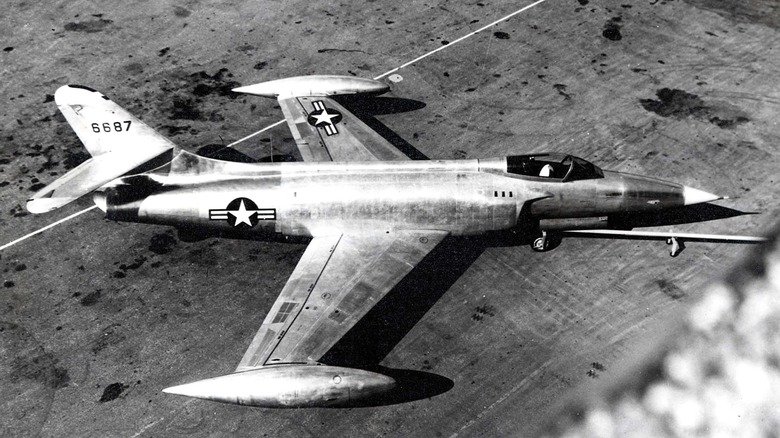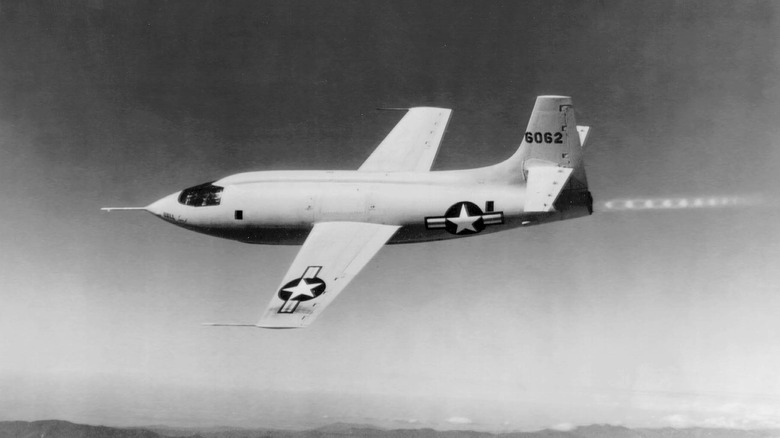10 Of The Most Impressive Experimental Fighter Jets That Never Entered Service
Traditional wisdom holds that wars are fought across land, sea, and air, and every new war brings about new innovations in the technology of violence. In the realm of aerial warfare, technology has advanced significantly since World War I. As the years have passed, propeller-powered biplanes armed with machine guns have given way to jet-powered, supersonic beasts armed with heat-seeking missiles, and technology will only advance further as humanity moves towards its unknown future.
However, not every innovation develops as expected. Below are several dead ends in the history of warplanes. Some of them are the result of companies sticking to old technologies facing obsolescence. Others were ahead of their time, trying to employ tech that wasn't quite ready. Still others were left behind by history after paving the way for future feats of aerial engineering, dooming themselves to obscurity within the footnotes of history. Here are 10 of the most impressive experimental fighter jets that never entered service.
F-18L
These days, F-18 Hornets are better known to some for embarrassingly falling off aircraft carriers than anything else. This is unfortunate because the F-18 is a remarkable aircraft that's widely considered among the best flying war machines ever built.
Beginning in the late 1970s, Northrop tried to improve upon the F-18 with the F-18L, with the "L" standing for "land," since it was modified to operate from airbases instead of aircraft carriers, like the traditional F-18. This change was an attempt to appeal to countries lacking aircraft carriers that still wanted to have the advantages provided by the F-18. Unfortunately, this led to legal quarreling between Northrop and McDonnell Douglas, since the two planes were in direct competition. Ultimately, these quarrels were irrelevant, since international interest towards the still-conceptual F-18L was low. When given the option, most countries opted for the classic F-18 or the older F-14.
While the F-18L was praiseworthy for its lower weight and higher performance than the classic F-18, it simply never caught the attention of international buyers, relegating the craft to the dustbin of history.
YF-93
Jet fighters such as the Messerschmitt 262 and Gloster Meteor saw combat during the Second World War, but it wasn't until the Cold War that jet fighters came into their own. Bombs got bigger, planes got faster, and the stakes grew ever higher as nuclear weapons and the threat of global annihilation took center stage.
The YF-93, from North American Aviation, was designed as an evolution of the existing F-86 Sabre design, and was deemed distinct enough to get its own designation. The YF-93 was designed to be the next generation of escort for bomber planes, but alas, it was not to be. The Boeing B-47 Stratojet was deemed fast enough not to require escorts. Two YF-93 prototypes were developed, and both were scrapped. As for the B-47, while it had successful reconnaissance runs in Soviet territory, it never saw actual combat.
EWR VJ 101
While several VTOL (vertical takeoff and landing) aircraft exist, most notably the Harrier Jump Jet, the concept has something of a bad reputation due to the poor safety record of the Osprey line of planes. The technology behind VTOL aircraft has been in development for well over 60 years, but the efforts of the United Kingdom, the United States, and other countries remain limited in scope.
Germany hoped to create a worthy successor to the F-104G Starfighter and, in 1963, tried its hand at VTOL tech with the EWR VJ 101. Two prototypes were built to lead to the next generation of fighter jets that could take off and land without the hassle of a paved runway, while remaining competitive with traditional fighter jets of the era. The EWR VJ 101 seemed promising, but the project was cancelled in 1968. For one thing, VTOL tech was increasingly seen as more trouble than it was worth. For another, the EWR VJ 101 was designed as an Interceptor, while the German air force wanted a more versatile plane that was incompatible with the design goals of the EWR VJ 101.
While the Harrier and the F-35 have proven the viability of VTOL capabilities in jet fighters, some view the technology as an expensive gimmick that has yet to reach its full potential in the world of air power.
XP-55 Ascender
Depending on how you look at it, the Curtiss-Wright XP-55 Ascender, which first took to the skies in 1943, could be seen as the first truly modern fighter craft. Unfortunately, it arrived way too early to be viable for practical use by the US armed forces. In hindsight, the XP-55 has several features that would become commonplace in the modern era: it has tricycle landing gear, canard wing configurations, and a propeller jettison device, which would detach the propeller before pilot ejection to prevent them from being sliced to ribbons if the plane were to be shot down.
There was one major modern amenity the XP-55 lacked: a jet engine. By 1944, it was clear that jet-powered fighters were integral to the future of military aviation, and the XP-55, despite all of its advances in other areas, would be outclassed before it even entered service. As a result, the project was scuttled, and the Lockheed XP-80 became the US military's first jet fighter. It also didn't help that two of the three XP-55 prototypes crashed during testing. The second crash, during an air show in Dayton, Ohio, tragically resulted in the deaths of the pilot and four bystanders. Clearly, there were still kinks in the XP-55 design that needed to be ironed out, and with the advent of jet technology, it simply wasn't worth the effort and expense of continuing development of the XP-55.
XF-87 Blackhawk
The Curtiss-Wright Company didn't have the best luck as World War II came to an end. After the cancellation of their XP-55 project, the company was in dire need of a successful and lucrative government contract. They believed their ticket to the future was the XF-87 Blackhawk. Unlike the XP-55, the Blackhawk was rooted in the sensibilities of the era, leveraging existing technology to craft its take on a next-gen fighter. It was jet-powered, with four engines and 20 mm guns for taking down the enemy.
Two prototypes were built and testing was slow but promising. Alas, history had other plans. Sometimes, fate is decided by a binary choice. Left or right. Do or do not. To be or not to be. In the end, the US government contract went to the Northrop F-89 Scorpion, which was seen as a better investment, and the Blackhawk was left behind. Curtiss-Wright decided to exit the aviation business, selling its holdings to North American Aviation.
Curtiss-Wright remained successful, however, through advancements in flight simulator technology, engine development, and aircraft and submarine component development. Today, Curtiss-Wright is worth multiple billions of dollars. Not bad for a company that knowingly sold defective engines to the US military during the height of World War II, a move that could have jeopardized the lives of American military personnel. It's always heartening to see a corporation bounce back from hardship. Did we say heartening? We meant the other thing.
Boulton Paul P.92
As mentioned earlier, war breeds innovation. When an existential threat to the free world pops up, like the German Nazis, Italian fascists, and Japanese imperialists did in World War II, the entire free world banded together to stop them (even if the USA took longer to join the fight than most of Allied Europe would have preferred), developing new technologies on the road to victory. However, some technological advances have to be curtailed for the sake of others. With that in mind, enter the Boulton Paul P.92.
The P.92 was to be a home-defense weapon for Britain, armed with a four-cannon turret and a bomb bay. A single prototype was built, but only at half-scale, and from wood instead of metal. However, with the Nazis rapidly carving their way through Europe, Britain cancelled the contract for the P.92, opting to focus on tried-and-true designs that could be battle ready with minimal delay. While the half-scale prototype was completed, the P.92 project was never revived.
Bell X-14
If we wanted to, we could fill this whole list with failed VTOL prototypes. But for the sake of variety, we'll limit ourselves to two: the aforementioned German EWR VJ 101, and this, America's own Bell X-14 prototype, which had its first flight in 1957. Unlike the German VTOL prototype, the engines of which would rotate to facilitate forward or vertical movement, the engines on the X-14 were fixed, with internal components redirecting thrust to accommodate directional movement.
The X-14's unique capabilities landed it in the hands of NASA, who used it as a Moon landing simulator, since delicate adjustments during VTOL descent were deemed comparable to a lunar lander descending to the surface of The Moon. It was piloted many times by Neil Armstrong, who, in 1969, would become the first man to set foot on the Moon. Needless to say, fuel efficiency is essential on the Moon, where the nearest gas station is 238,000 miles away.
While the X-14 proved instrumental in developing and understanding VTOL technology, it was never destined to become a fighter on its own. With its open-cockpit design and lack of weaponry, the X-14 was a testbed for new technology. After being decommissioned in 1981, the Bell X-14 went into storage before being unceremoniously dumped in a scrapyard. However, its remains were picked up by Rick Ropkey, owner of the Ropkey Armor and Aviation Museum. For the last 30 years, his family has been slowly restoring the X-14 to its rightful glory, one piece at a time.
Bensen B-8 (X-25B variant)
Autogyros are equal parts terrifying and cool. They're absurd little vehicles that offer next to zero protection from the elements. Imagine a bicycle that flies thanks to a pair of propellers that are dangerously close to the pilot, who doesn't even have the comfort of a cockpit to keep them safe. The Bensen B-8, one of the most noteworthy gyro designs in history, is not the subject of this entry. After all, it was successful and not a military vehicle.
This entry is actually about the little-known X-25B variant of the Bensen B-8 design, which was commissioned by the United States Air Force as part of a program called DDV, or Discretionary Descent Vehicle, in 1968. While gyrocopters are usually meant to bring people up into the sky with virtually no barrier between them and the open air (or a flock of aggressive geese), the X-25B was essentially the opposite. It was meant to be attached to the ejector seats of Vietnam-era fighters so that pilots could control their descent after being shot down. If a plane were shot down over enemy territory, the pilot could drift away from enemy lines and land on safer, friendlier ground. Alas, the project never made it to any kind of wide testing and was quietly discontinued as the Vietnam War drew to a close.
Lockheed XF-90
After the end of World War II, as bombers grew faster and faster, so too did the need for speedier escort jets. This led Lockheed to develop the XF-90, their first jet to incorporate an afterburner for maximum thrust on takeoff. Despite this addition, the jet was still considered to be underpowered. Lockheed surely would have figured out how to improve on the XF-90, but they were beaten to the punch by the McDonnell XF-88 Voodoo, which was granted an Air Force production contract in 1950.
Curiously, the XF-88 Voodoo never made it to the assembly line. It was discarded in favor of the F-101 Voodoo, which managed a production run of over 800 units. As for Lockheed's XF-90, its legacy would come from — of all places — the pages of "Blackhawk," by Quality Comics, and later, DC Comics. In the 1950s, the eponymous group of fighter pilots flew "F-90" jet fighters, thinly-veiled ersatz versions of the XF-90.
Bell X-1
The first man to break the sound barrier was Chuck Yeager, and he did so in the cockpit of a Bell X-1 back in 1947, ushering in a new era of aviation. The moment was dramatized in the film "The Right Stuff," with actor Sam Shepard playing Chuck Yeager. The historic flight served as a statement of intent from humanity: they had conquered the air, and space travel was next. The revised X-1A passed 1600 MPH in 1954, just four years before the Explorer 1 marked America's first successful satellite launch in 1958 (which happened in the wake of the Soviet Union's successful launch of the Sputnik satellite).
The X-1, as its name suggests, was the original experimental "X-Plane," intended to test new technologies that would form the foundation of the next generation of aerial warfighters. The X-1 was never going to be a jet fighter itself, but make no mistake: the entire space program, as well as every rocket-powered jet flying today, wouldn't exist without the innovation of the X-1.
All told, seven X-1 planes were built. Several were lost due to explosive crashes, but three are on display at various museums and Air Force bases across the United States.
